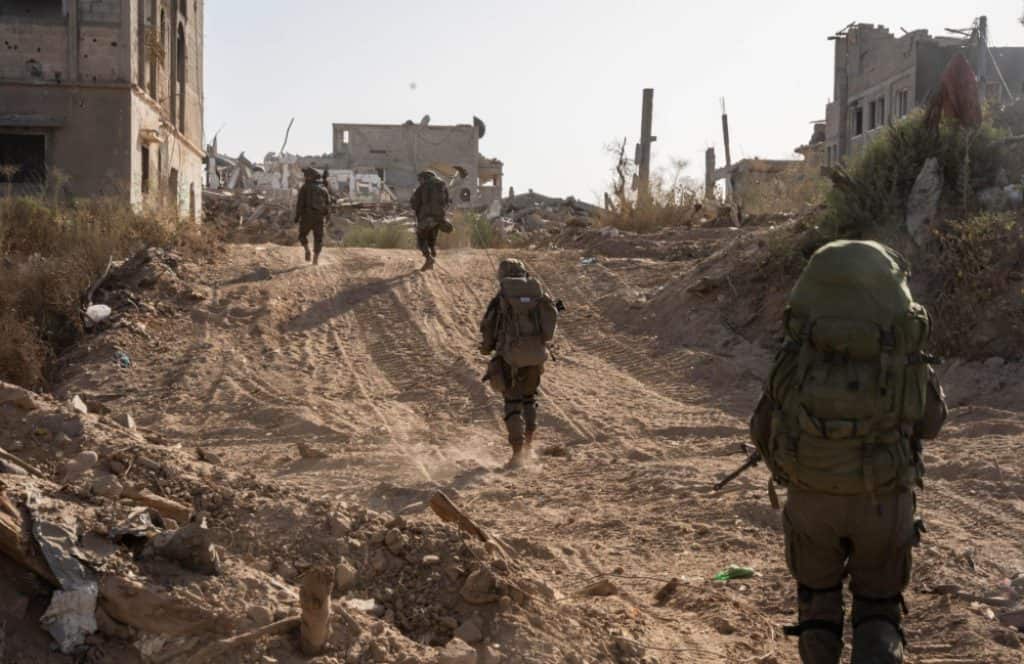
Two Israelis were killed in a large rocket barrage on the Golan Heights on July 9. Hezbollah claimed it targeted several Israel Defense Forces (IDF) posts in response to the killing of one of its members on a road that leads from Damascus to Beirut. Hezbollah said it had targeted the IDF’s 210th Division, the unit responsible for protecting the Golan front, using “dozens” of Katyusha-style rockets.
The IDF said that “approximately 40 projectiles crossed from Lebanon into the area of the central Golan Heights. Several projectiles were identified falling in the area.” Sirens sounded in the area due to the attack.
On the same day as Hezbollah’s attack, Israel faced threats on other fronts. The Iranian-backed Houthis claimed to have targeted Israel in a “joint” operation with Iranian-backed groups in Iraq. The IDF said it intercepted threats on the morning of July 8 and the morning of July 9 that appeared to match the Houthi statements.
In Gaza, the Israel Defense Forces operated in several areas, including southern Gaza’s Rafah, as well as neighborhoods in the northern part of the strip. Multiple raids in northern Gaza happened alongside airstrikes in central Gaza that hit terrorists operating there. Hamas continues to exercise control of much of central Gaza and most of Gaza’s north, despite the IDF’s success in clearing Hamas from Rafah and the Netzarim Corridor, which cuts off northern Gaza from central Gaza.
The IDF’s 98th Division led the return to Shejaiya in late June after Israeli forces had cleared the neighborhood earlier in the war and withdrawn. The 98th Division includes paratroopers and elements of the 7th Armored Brigade and the Yahalom Combat Engineering Unit for Special Operations.
“The soldiers of the division engaged in close-quarters combat with terrorist cells and eliminated more than 150 terrorists, dismantled terrorist infrastructure and encountered and destroyed booby-trapped buildings and explosives. In addition, the soldiers located dozens of weapons and intelligence documents that the terrorists left behind,” the IDF said on June 9.
In addition, the IDF published footage of the destruction of Hamas tunnels in Shejaiya and stated units had destroyed six tunnels that were around four miles long in total. These passages are just some of the hundreds of tunnels and tunnel shafts the IDF has located and destroyed in nine months of fighting. Israel has found that the extent of Hamas’s underground infrastructure is far larger than expected as fighting has continued.
Estimates that the tunnels may stretch some 350 miles mean that those found in a week of fighting in Shejaiya represent only one percent of the total. Nevertheless, many other miles of tunnels have been destroyed, though the IDF has not provided an overall estimate of the total recently. With each Israeli sweep of areas such as Shejaiya, it finds more tunnels and weapons, though the numbers appear to be diminishing each time.
The IDF provided further details about searching the underground passages. “During the examination of the tunnels, the soldiers of the Yahalom Unit located underground tunnels consisting of a branched tunnel system. In some of the branches, terrorists’ hideouts and control and command centers were located. In one of the tunnels, weapons and intelligence documents were located,” a statement noted.
The expanded threats to Israel by Hezbollah, as well as the Houthis and Iranian-backed militias in Iraq, illustrate that Iran continues to wage a multi-front war against Israel nine months into the Gaza conflict. Hezbollah’s attack in the Golan comes days after an American citizen was severely wounded by an anti-tank missile the group fired on the Israeli border community of Zarit. It also follows Hezbollah launching a barrage targeting areas in the central Galilee, around 20 miles from the Lebanon border.
Hezbollah is telegraphing that its attacks could grow. The group published footage from drones that overflew Israel earlier this year showing various Israeli military posts. Hezbollah is suggesting it can carry out precision strikes on these locations based on the intelligence it has gathered.







